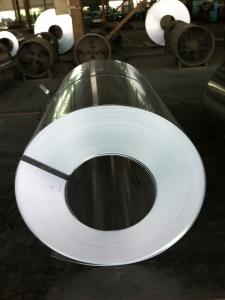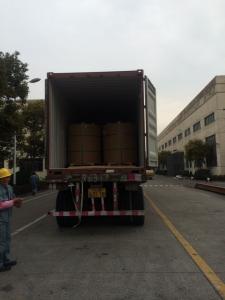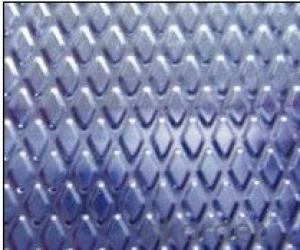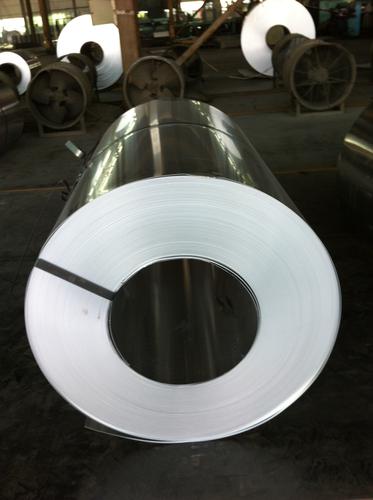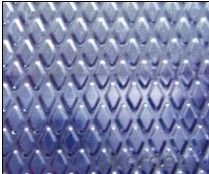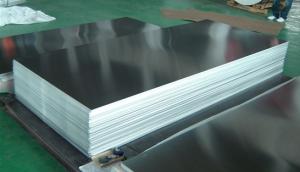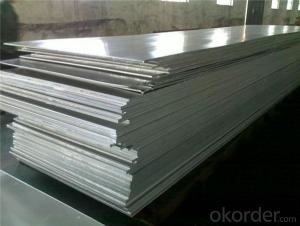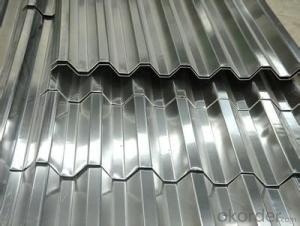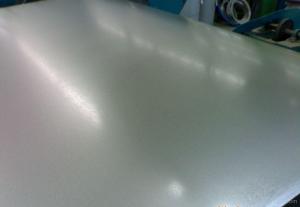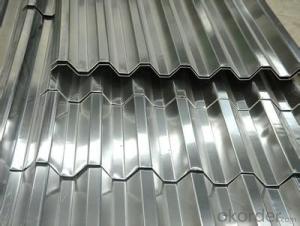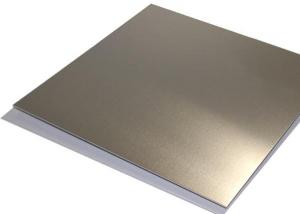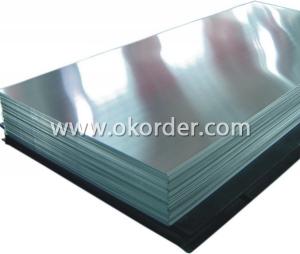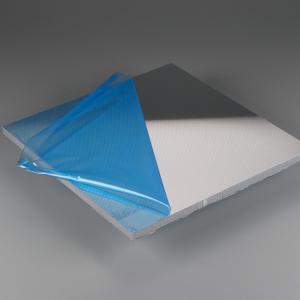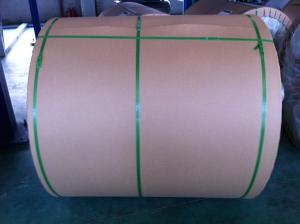1100-H24 Corrugated Metal Aluminum Sheets and Plates
- Loading Port:
- Shanghai
- Payment Terms:
- TT OR LC
- Min Order Qty:
- 5 m.t
- Supply Capability:
- 3000 m.t/month
OKorder Service Pledge
OKorder Financial Service
You Might Also Like
1.Structure of Product Description
Cold rolled aluminum sheet is widely used in the field of construction field and decoration field, etc.
There are many different grades, such as: 1000 series, 2000 series, 3000 series, 5000 series, 6000series, etc.
The temper is include H14, H22, H24, H44,H112,H114,etc.
2. Main features of the product
a.Competitive price
b.Frist-Class Service.
c. Shortest service.
3. Image.
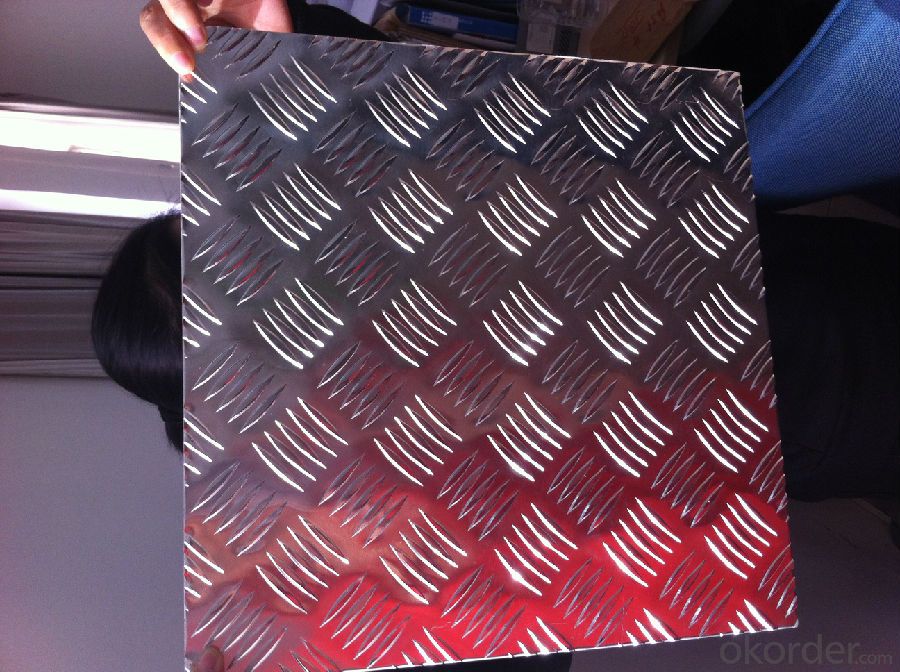
4. Product detailed sizes:
1000mm*2000mm, 1219mm*2438mm,1220mm*2440mm, 1250mm*2500mm,1500mm*3000mm, etc.
5. FAQ:
What is the quality standard?
---Usually our standard is GB3880-2006 or others.
What is the width range?
---It is from 1000mm to 2500mm, etc.
What is the length range:
---It is from 2000mm to 6000mm, etc.
What is the MOQ for your products yet?
---Normally it is around 5 tons/each size.
How many tons did you export in one year?
---Normally it is around 9000 tons totally.
Where is your client from?
---Normally it is from Japan, USA, ENGLISH, SINGAPORE, ETC.
What is your mainly products?
---Normally they are aluminum sheet, checkered sheet, mirror finish aluminium sheet, aluminum casting coil, etc.
- Q: What is the main influence of the spacing?What are the main effects of spacing?
- Thermal explosion is related to a lot of factors. As to how much impact the lining board has on the thermal explosion, it's really impossible to speak of it. I think it has very little influence
- Q: What are the distinctions between standard aluminum windows and those that are custom-made?
- <p>Standard aluminum windows are mass-produced and come in set sizes and styles, offering affordability and quick installation. They may not fit perfectly into unique spaces and may lack customization options. Custom-made aluminum windows, on the other hand, are tailored to specific dimensions and design preferences, ensuring a perfect fit and enhanced aesthetics. They often come with more features and options, such as energy efficiency, security, and unique styling, but are typically more expensive and have a longer lead time for production and installation.</p>
- Q: Are aluminum sheets easy to clean and maintain?
- Yes, aluminum sheets are generally easy to clean and maintain. They can be easily wiped clean with a damp cloth or sponge, and occasional cleaning with mild soap and water is usually sufficient. Additionally, aluminum is resistant to rust and corrosion, making it relatively low maintenance in comparison to other materials.
- Q: Are aluminum sheets suitable for roofing systems?
- Yes, aluminum sheets are suitable for roofing systems. Aluminum is a popular choice for roofing due to its durability, lightweight nature, and resistance to corrosion. It is also fire resistant and can withstand extreme weather conditions such as high winds and heavy rain. Aluminum roofing sheets are long-lasting and require minimal maintenance, making them a cost-effective option in the long run. Additionally, aluminum is a highly reflective material, which can help in reducing energy costs by keeping buildings cooler in hot climates. Overall, aluminum sheets are a reliable and efficient choice for roofing systems.
- Q: Are aluminum sheets suitable for interior design applications?
- Aluminum sheets are an excellent choice for interior design purposes. This material is both versatile and durable, allowing for various creative uses in enhancing the aesthetics of indoor spaces. Its malleability enables easy shaping, cutting, and manipulation, resulting in unique and contemporary designs. Different finishes, such as brushed, polished, or textured, further expand the design options. One major advantage of utilizing aluminum sheets in interior design is their lightweight composition. This feature simplifies handling and installation, reducing labor and transportation expenses. Additionally, aluminum's corrosion resistance makes it perfect for environments with high humidity or moisture, such as bathrooms or kitchens. Aluminum sheets find application in various aspects of interior design, including wall cladding, ceiling panels, room dividers, furniture, and decorative elements. The ability to paint or coat them in different colors allows seamless integration into any design scheme. Furthermore, perforation or engraving can create patterns or intricate designs, adding a distinct visual appeal to the space. Moreover, aluminum is a sustainable material with high recyclability. The recycling process consumes significantly less energy compared to the production of new aluminum, making it an environmentally friendly option for interior design applications. To summarize, the versatility, durability, lightweight nature, corrosion resistance, and manipulability of aluminum sheets make them highly suitable for interior design. They offer numerous design possibilities and can be used in various applications, rendering them a popular choice among designers and architects.
- Q: Can 101 aluminum sheets be used in the production of nameplates or tags?
- Yes, 101 aluminum sheets can be used in the production of nameplates or tags. Aluminum is a popular material choice for nameplates and tags due to its durability, lightweight nature, and resistance to corrosion. The 101 aluminum alloy, which is a commercially pure aluminum, offers excellent formability and workability, making it suitable for various manufacturing processes such as stamping, engraving, or etching. It can be easily cut, shaped, and customized to create high-quality nameplates or tags with clear and precise markings. Additionally, aluminum's ability to withstand harsh environments and its attractive appearance make it a preferred choice for many industries, including automotive, aerospace, electronics, and signage. Therefore, 101 aluminum sheets are a suitable material for the production of nameplates or tags.
- Q: Can 101 aluminum sheets be perforated?
- Yes, 101 aluminum sheets can be perforated.
- Q: What precautions should be taken while handling aluminum sheets to ensure safety?
- <p>When working with aluminum sheets, it's important to take certain safety measures. Always wear appropriate personal protective equipment (PPE) such as gloves, safety glasses, and a dust mask to protect against sharp edges and metal dust. Ensure good ventilation to avoid inhaling aluminum dust, which can be harmful. Use proper tools designed for metal work to prevent accidents. Keep the work area clean and free from clutter to minimize trip hazards. Be cautious of electrical hazards if using power tools, and ensure all tools are in good working order. Finally, be aware of the fire hazard potential of aluminum, especially when cutting or welding, and have fire extinguishers readily available.</p>
- Q: What are the different methods of surface cleaning aluminum sheets?
- There are several methods for surface cleaning aluminum sheets, depending on the level of dirt or contamination present. Here are some of the most commonly used methods: 1. Mechanical Cleaning: This method involves physically scrubbing the surface of the aluminum sheet using brushes, abrasive pads, or sandpaper. It is effective for removing light dirt, grease, or oxidation. However, caution should be exercised to avoid scratching or damaging the surface. 2. Chemical Cleaning: Chemical cleaning involves the use of specific cleaning agents or solutions to remove dirt, stains, or oxidation from the aluminum sheet. Commonly used chemicals include alkaline cleaners, acidic cleaners, and solvents. It is important to follow the manufacturer's instructions and take necessary safety precautions when working with chemicals. 3. Pressure Washing: Pressure washing utilizes high-pressure water jets to remove dirt, grime, and other contaminants from the surface of aluminum sheets. It is a quick and efficient method, particularly for large or heavily soiled surfaces. However, care should be taken to avoid using excessive pressure, which may dent or damage the aluminum. 4. Electrolytic Cleaning: This method involves the use of an electrolyte solution and an electric current to remove corrosion, oxidation, or tarnish from the aluminum sheet. The sheet is submerged in the electrolyte bath, and the electric current helps to dissolve the contaminants. Electrolytic cleaning is particularly effective for heavily oxidized or tarnished surfaces. 5. Chemical Etching: Chemical etching is a process that uses a combination of chemicals to selectively remove the surface layer of the aluminum sheet. It is commonly used for removing anodized coatings or for creating decorative patterns on the surface. However, this method requires specialized equipment and expertise. It is important to note that the choice of cleaning method should be based on the specific requirements of the aluminum sheet, the level of contamination, and the desired outcome. It is always recommended to consult the manufacturer's guidelines or seek professional advice to ensure the most appropriate and safe cleaning method is used.
- Q: Are 101 aluminum sheets suitable for mold making?
- No, 101 aluminum sheets are generally not suitable for mold making. While aluminum is a commonly used material for making molds due to its durability and heat resistance, 101 aluminum is a low-strength alloy that may not meet the requirements for mold making. For such purposes, it is recommended to use aluminum alloys with higher strength and hardness, such as 6061 or 7075 alloys. These alloys offer better resistance to wear, deformation, and heat, making them more suitable for creating molds that can withstand the pressures and temperatures involved in the molding process.
Send your message to us
1100-H24 Corrugated Metal Aluminum Sheets and Plates
- Loading Port:
- Shanghai
- Payment Terms:
- TT OR LC
- Min Order Qty:
- 5 m.t
- Supply Capability:
- 3000 m.t/month
OKorder Service Pledge
OKorder Financial Service
Similar products
Hot products
Hot Searches
Related keywords
